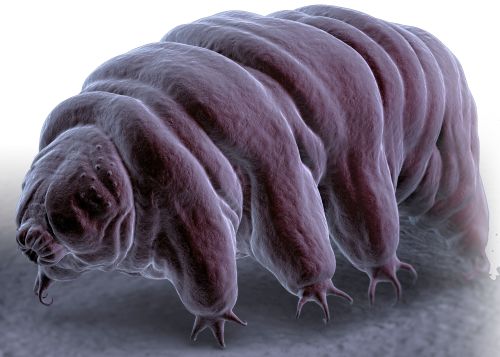Tardigrades too tough for evolution

The toughest animals on Earth are the ‘tardigrades’—aka ‘moss piglets’, ‘bear animalcules’ or ‘water bears’. Mostly less than 1 mm (1/25 inch) long, they can survive conditions far worse than any they would ever experience on Earth.
For example, they can endure being frozen in liquid helium (-267ºC, or -452ºF), only a few degrees above absolute zero (-273.15ºC, or -459.67ºF), the lowest temperature possible. They can also survive being heated to 151ºC (304ºF), being put in a vacuum and bombarded with electrons, and being subjected to extraordinarily high water pressures, 600 MPa (6,000 atmospheres)—six times greater than at the bottom of Earth’s deepest ocean. And they can withstand being zapped with X-rays 250 times more intense than would kill a person.
Faced with extreme conditions, tardigrades curl in their head and legs tightly, roll up into a barrel-like shape, and shut down their metabolism—even their respiration stops completely. This resting stage, called a ‘tun’, is highly resistant to extreme conditions.
Recent research into this amazing resilience found that the radiation resistance of the tardigrade species Ramazzottius varieornatus was due to a special protein dubbed Dsup, (for ‘Damage suppression’).1,2 Dsup proteins surround the tardigrade’s DNA to protect it from radiation harm, while keeping all of its normal functions intact. Dsup can also clean out DNA-damaging agents known as reactive oxygen species. So when favourable circumstances return, the tardigrade revives—amazingly, showing no ill effects whatsoever.
However, in researching ‘how this works’, the tough question (for evolutionists) of ‘how did this come about?’ is generally evaded. The thing is, tardigrades are too tough for evolution to have brought them into existence.3 Natural selection can only select characteristics necessary for immediate survival. Consequently, evolution cannot be expected to over-engineer creatures for a host of environments they have never faced.4 Also, proteins around DNA would normally hinder reproduction; so, while the (designed) tardigrade Dsup brilliantly avoids this, selection would work against a partly-evolved version.
So anyone challenging Christianity by asking for evidence against evolution and for a Creator need look no further than the tardigrades. A tough lesson perhaps (John 3:19, 2 Thessalonians 2:11–12), but true.
References and notes
- Hashimoto, T. et al., Extremotolerant tardigrade genome and improved radiotolerance of human cultured cells by tardigrade-unique protein, Nature Communications 7:12808, 20 September 2016 | doi:10.1038/ncomms12808. Also comment same issue: Bittel, J. Tardigrade protein helps human DNA withstand radiation | doi:10.1038/nature.2016.20648. Return to text
- ‘Radiation shield’ found hidden in water bear genome, sciencemag.org, 20 September 2016. Return to text
- Vetter, J., The ‘little bears’ that evolutionary theory can’t bear!, Creation 12(2):16–18, 1990; creation.com/water-bears. Return to text
- Catchpoole, D., Life at the extremes, Creation 24(1):40–44, 2001; creation.com/extreme. Return to text




Readers’ comments
Comments are automatically closed 14 days after publication.